History of Baseball Video Games #10 - Nintendo's Bases Loaded
By jbn566 1 Comments
This is a series of blogs based on my own personal game collection. I will attempt to go through them in a chronological order according to their release date. I will also attempt to play then on their original platform using the original controllers the game was designed for. If I am unable to get the system or the game working then I will use PC emulation or another platform emulation like the Intellivision Lives! game for the gamecube
Previous entries
| 5. Microvision's Baseball (1980) 6. Atari 2600's RealSports Baseball (1982) 7. Nintendo's Baseball (1983) 8. Intellivision's World Championship Baseball (1983) 9. Sega Master System's Great Baseball (1987) |
Bases Loaded for Nintendo Entertainment System (1987)
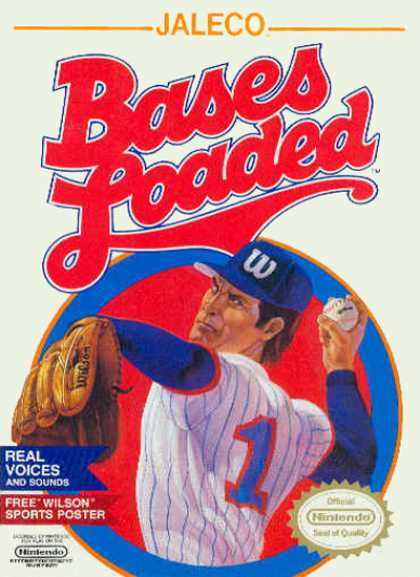
If I had to do this list based on which baseball games I enjoyed playing in my youth, Bases Loaded for the NES would be the game. I fell in love with this game as a kid and I remember endless hours in front of the TV playing this game. I used to keep a notepad next to my NES just for games like this. This game you can play a whole 80 game season and after each game you are presented with a password to save your progress. This is before internet so my notepad filled with passwords became the most important sheets of paper ever to exist. I have been looking forward to going back and playing this game ever since I decided to start this blog. I wasn't the only one playing this game at the time, a couple years later a sequel was released and at which time became a game franchise across multiple platforms. This is one of the first baseball games to accomplish this feat. Baseball games up this point were one and done. Let's see how the Bases Loaded franchise started.
Graphics
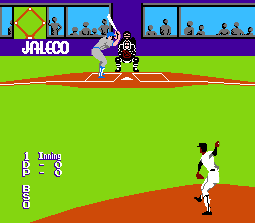
Sega's Great Baseball and Nintendo's Bases Loaded were released within months of each other in Japan. Because of these close release dates it is hard to determine which game established the infamous behind the pitcher camera view during the pitcher/batter duel. To this day when you read reviews of the game people either enjoy this view or don't, for the record I enjoy it. I find that I can see balls and strikes easier than what we have had in past games which were from the top down perspective. Not only was this view enjoyable to play in but they included simple touches to addma nice realism to the experience as if you are watching the game on TV. Like Great Baseball, they included a picture-in-picture bird's eye view of the infield so you can see where the bases runners are currently positioned. Unlike Great Baseball, it was better positioned and didn't float in the air and get in the way of the action. It was positioned along the backstop and part of the wall. The text is also readable and I always knew the current count and score. The batters count uses baseballs as icons which always make things easy to understand.
Players
I mentioned the simple truth that I love 80's baseball uniforms in the last blog entry and this game doesn't disappoint. The stirrups are nicely rendered and as well as the high socks. Because of the behind the pitcher view we now can see their uniform number printed on the back of the uniform. Can video game graphics get any more real than this? The outfield top down view is zoomed out and thus the players don't have much detail however. I wish someday developers can be more creative with these outfield views. The players have different skin color which makes it more real as well. One of the greatest and yet simplest graphical advancement this game introduces us to is different batting stances for the players. Not only does each batter have different stats associated them but now are graphically different. Each batter does not have a unique stance but instead 1 of 3 different stances.
| Three different batting stances | ||
|---|---|---|
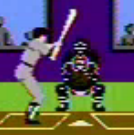 | 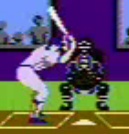 | 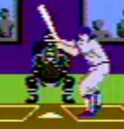 |
Field
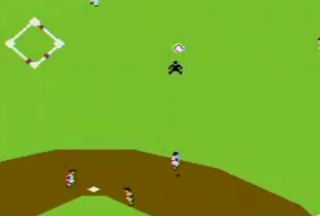
Right from the start I should mention that while the NES was not the most powerful machine out there in 1987, what it have was a dedicated set of code for screen scrolling. Scrolling on the NES is very smooth compared to other systems. With this added ability, Bases Loaded naturally becomes one of the first baseball games to invoke scrolling during the play. We are now at a time where the camera doesn't have to be zoomed out to show the entire field and all fielders on the screen at the same time. When the ball is hit the camera follows the ball and the field scrolls behind it. Playing the game this way has its advantages and disadvantages. One of the disadvantages is when the ball is hit towards the outfield your fielder is not always visible on the screen and you don't really know what direction you should move to collect or catch the ball. The advantage to this approach is when you throw the ball from the outfield to the infield or when the ball hits out to the outfield the screen smoothly follows the ball and doesn't require change of the camera view which might get disorientated users for a critical split second. As far as concepts of the field that is new to video games, we now have the on deck circle and the base coach areas along 1st and 3rd base.
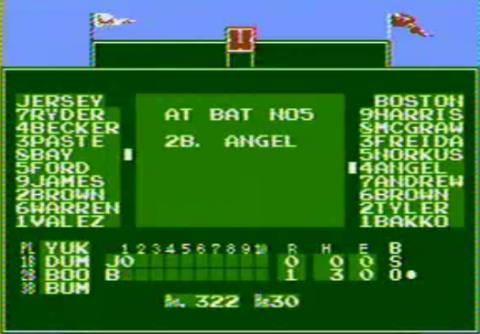
The scoreboard is something we are starting to see improved with each game. We have gone from not having any at all to animations in the jumbotron like we see in real ball parks in the 80's. The scoreboard provides more information. It now displays the lineup of teams as well as the current batter's average as well as number of home runs. The scoreboard includes a unique feature I haven't seen before and the initials of all the umpires. The flags on top of the scoreboard did not wave in the air and are static. The cut scenes on the scoreboard occurred during homeruns, pitch hitting and bringing in a relief pitcher. Calling another pitcher was my favorite since this was during the time when a golf cart actually went on the field and dropped off the pitcher... I love the 80's.
Fans
The crowds in this game are slightly disappointing. They are shown during the game but very boring and dull. The one thing that does exist though is there are fans displayed during the pitcher/battle duel. They are individual people but a solid grey and they are not animated.
Home Run Celebration
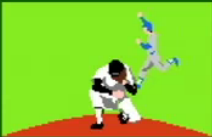
Hands down the best home run celebration to date exists in this game. As soon as the ball hits the stands, the camera moves to the scoreboard with the big letters "Home Run" then the scoreboard is zoomed in and takes up the entire screen where a video of the pitcher is shown kneeling down in disgust as the base runner is shown running behind him pumping his fists in the air. If there are other base runners during a home run they don't leave for the dugout after touching home plate but rather stay on the field and provides high fives.
Camera/Screen
I already mentioned it but shouldn't be forgotten this game's camera work is one of the kind. Never before has the camera actually followed the ball like it does in this game. In previous games the camera was static; everything had to be seen in one camera angle, which is why bird's eye view was the most popular way to show all the action. This game helped introduced the behind the pitcher camera during pitches. The scoreboard camera provided the user all the game info including rosters, current batters and menus for managers such as selecting a new pitcher. While the moving camera was not perfect, it is a start and great innovation for the industry.
Sounds
The sound chip in the NES is pretty impressive and we have heard some great melodies from previous games such as Super Mario but none of the sports games are that memorable including this game. The melodies in the game are nice and quick. They occur during the home run, every half inning and whenever there is a pause of the game. One of the small addition to the sound of the game that I enjoyed was when you pause the game you can hear the umpire call time. The umpire's voice is clear and doesn't sound like a robot as previous games sounded.
Gameplay - Modes
There are only two modes in this game; Pennant and vs. Mode. The first option is only for single players in which you try to play an 80 game season with your team. After each game you are given a password so you can continue the season at a later date. In the 80's I managed to complete the entire season which was a video game memory I will never forget. This concept of playing an entire season was amazing for its time and something that I always look for to this day when I play any baseball game.
Gameplay - Defense
Standard controls for the defense side of the ball. With the scrolling of the field it does make it hard to know where your fielder is sometimes but in general if you don't touch the controller the CPU moves your fielder towards the ball anyways. I find that this helps a great deal once the ball is in the air. Instead of just throwing to a base with the other button you can now run to a base. This helps with when you catch someone stealing. The pitching is standard as well, with the d-pad you select the type of pitch. You can change pitchers at any time. I found the ball to move more natural than previous games. It doesn't appear to float into the fielder’s glove as well as it travels faster than the base runners as it should
Gameplay - Offense
I might be incorrect but I believe this was is the first game in this blog series where I feel I have control over the direction of the bat as I swing. I cannot move the batter in the batter box but I feel using the d-pad I can hit an high and tight pitch as well as a low golf type swing. When you have base runners you do have control over which runner you want advance. At any time you can select to pitch hit. The batter's avg and home run count appear to matter in the game, as there are power hitters and non-power hitters.
Rules of Baseball
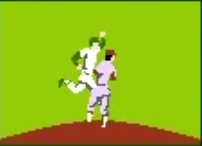
The greatest thing about this game is the fact when the pitcher hits the batter not only do you get to go to first base but there is a chance the batter will charge the mound and a good old fashion brawl will occur which you can follow on the jumbotron. After the fight is over you are forced to select a pinch-runner for the batter has been ejected from the game. If this isn't the best aspect of baseball to be incorporated in a video game I don't know what is. I also like the umpire movements behind the plate and on the field.
We can pitch-hit, pitch-run, change pitchers but that is all we can do regarding game management. We do have a line up but currently have yet been able to manage the line up before the games. We can however select a pitcher which the only pitching stat we can go by is ERA.
Video Game Innovations
- Charging the mound after being hit by the pitch
- Umpire calling 'time' when you pause the game
- Cut scenes during manager choices such as pitch-hiting and changing pitchers
- Camera follows the ball and the field scrolls
- Single player 80 game season mode
- Password system to manage season
- Numbers on uniforms
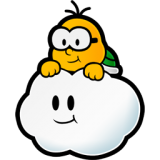
1 Comments